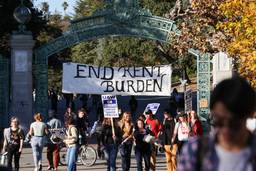Meet the Students Trying to Organize the First Campus-Wide Undergraduate Union
Inside the groundbreaking student organizing drive at Kenyon College.
Indigo Olivier labor

On August 31, students at Kenyon College, a private liberal arts college in Gambier, Ohio, announced their intent to unionize with the United Electrical, Radio and Machine Workers of America (UE) in an open letter to the school’s president and board of trustees. Students have requested voluntary recognition through a card-check neutrality agreement with the school’s administration. If successful, the Kenyon Student Worker Organizing Committee (K-SWOC) will become the first union to organize its entire undergraduate workforce, which will include all 800 student worker positions available on campus.
“This is a history making campaign,” says Dan Napsha, a senior majoring in political science. “If we win, it really does send a message that this is possible and that student workers should be asking for more.”
Labor Day wrapped up a week of action by student organizers, which included testimonials from student workers, panels on international labor and racial justice and virtual socials and concluded with endorsements from Sens. Sherrod Brown (D-Ohio) and Bernie Sanders (I-Vt.). In a letter of support to Kenyon student workers, Sanders wrote, “When you and your colleagues join together as a union, the administration will be required to bargain with you in good faith… I respect the critical work you do and wish you the very best in your efforts to create a democratic workplace where your voice has a seat at the table.”
Disruption in campus employment due to the Covid-19 pandemic sparked new urgency for students’ ability to bargain with the school. When Kenyon closed its campus and switched to remote learning in March, many students had their work hours cut or stopped working entirely. Undergraduate jobs include working in the dining hall, library, admissions office and as research assistants. Students say there was a lack of certainty around their employment status or working conditions that has carried over into the Fall semester which started August 31 and has about half of the student body on campus and the other half learning remotely.
“The pandemic really served as the catalyst for us and basically was a signal that enough is enough — that we’re fed up,” says Napsha.
In late March, a petition signed by over 200 members of the college community and sponsored by Kenyon Young Democratic Socialists of America (KYDSA) to secure student pay for the rest of the school year proved successful. Though the administration did not acknowledge the petition, students were paid for their average weekly hours regardless of their ability to work remotely. A few months later, when the administration announced it would be suspending retirement benefits for Kenyon staff due to a $19.3 million deficit in the school’s operating budget, another petition, again initiated by KYDSA, was circulated to “stop the cuts.” With the support of students, UE, which represents the maintenance workers on campus, was able to come to an agreement with the administration that the majority of the missed retirement benefits be refunded to employees over a period of three years.
“Both of those [petitions] prompted more conversations about some of the broader, more structural issues with student employment,” says Nathan Geesing, a senior majoring in history. “That was a sign to organizers that collective action really had an impact.”
Seeing the outcome of both petitions reaffirmed to students that a union would be the best way to move forward. Geesing says a union is ”a mechanism to bargain with the administration, to not have to rely on the administration’s endless slew of task forces and working groups that constantly promise change, but rarely, if ever, deliver.” Right now, wages for student workers fall into a three-tier wage system starting at $8.70 an hour and capped at $11.17 an hour. Students say these rates are arbitrary and do not reflect the necessary labor they perform on campus and instead reflect a desire to save the school money. The wage system was determined jointly by a now disbanded “Student Employment Task Force.”
”The administration has never really taken student demands or student concerns seriously,” says Geesing. K-SWOC’s demands include greater involvement in workplace decision-making, greater protections and accessibility for work-study students, justice for international student workers and a living wage, among others. Though students have not agreed on a dollar figure, they say a living wage would be high enough that students don’t have to feel like they’re choosing between work and their academic studies. “The union could actually give us the bargaining power that we need, especially in a time like this, where not having a say in your reopening plan can literally be a matter of life and death,” Geesing says.
Kenyon students, who are both organizing under unprecedented circumstances and breaking new ground by organizing their entire undergraduate workforce, have limited examples to point to as a model. Most student worker unions are concentrated among graduate students in public universities, though University of Massachusetts Amherst and Grinnell College, which managed to organize individual shops among undergraduate resident advisors and dining workers, has served as a source of inspiration for K-SWOC organizers.
“I imagine that if we succeed, you’ll be seeing a lot more unions on college campuses,” says Napsha. “Partly because we are building off of the Grinnell model and we are building off of the UMass Amherst model.”
”In a larger sense,” Geesing says, “having a union at Kenyon could serve as a source of inspiration for student workers in others places in the country to say if they can do it, why can’t we.”
A major source of support has come from the maintenance workers on campus, a student-labor alliance that dates back to 2012 when the administration attempted to outsource maintenance jobs to Sodexo, a food and facilities management company with nearly half a million employees worldwide. ”They’ve given us a kind of mentorship that’s really valuable,” says Dani Martinez, a senior majoring in English. “They definitely want the best for us because they have similar things that they have fought for in the past and can give us guidance on those things too.”
The maintenance workers, who are represented by UE Local 712, helped initiate a relationship between students on campus and UE, with whom they are now organizing with. The maintenance workers, Napsha says, have “been partners with us through this entire process. The reason why we have been so successful — getting close to 200 cards signed, having hundreds of people organized and having a 60 person strong organizing team is because of the strength of our relationship with UE.”
As of Labor Day, K-SWOC has sent two requests for voluntary recognition of their union and the response from the administration has mostly been silence. Meanwhile, many students whose jobs cannot be performed remotely lack clarity around their employment status for this semester and next. Martinez believes that students who cannot work remotely should be transferred and trained in a different department with priority given to students with work-study, a federally-funded program that is supposed to guarantee campus employment as part of their financial aid package.
Martinez, who has worked in library and information services since she was a freshman, says her employment status is still up in the air. With Kenyon’s administration ultimately deciding on a system of teaching freshman and sophomores on campus and teaching juniors and seniors remotely, many in-person jobs will not be available this semester and union organizing continues to be almost entirely remote — a strategy Napsha and Geesing say may be playing in their favor especially with many students now stuck at home with limited in-person distractions.
Those students who are working remotely and are living outside of Ohio are now being paid according to the state minimum wage where students are based if it exceeds Kenyon wages. Geesing, who is living in Maryland where the minimum wage is higher, says he got an email from the career development office over the summer informing him that he’d be paid a bonus to make up the wage difference. Geesing says it “just shows you how completely arbitrary the tiered system has been and how they could have paid us more the entire time.”
Indigo Olivier is a reporter-researcher for The New Republic and a 2020-2021 Leonard C. Goodman investigative reporting fellow. Her writing on politics, labor and higher education has appeared in the Guardian, The Nation and Jacobin, among other outlets.








